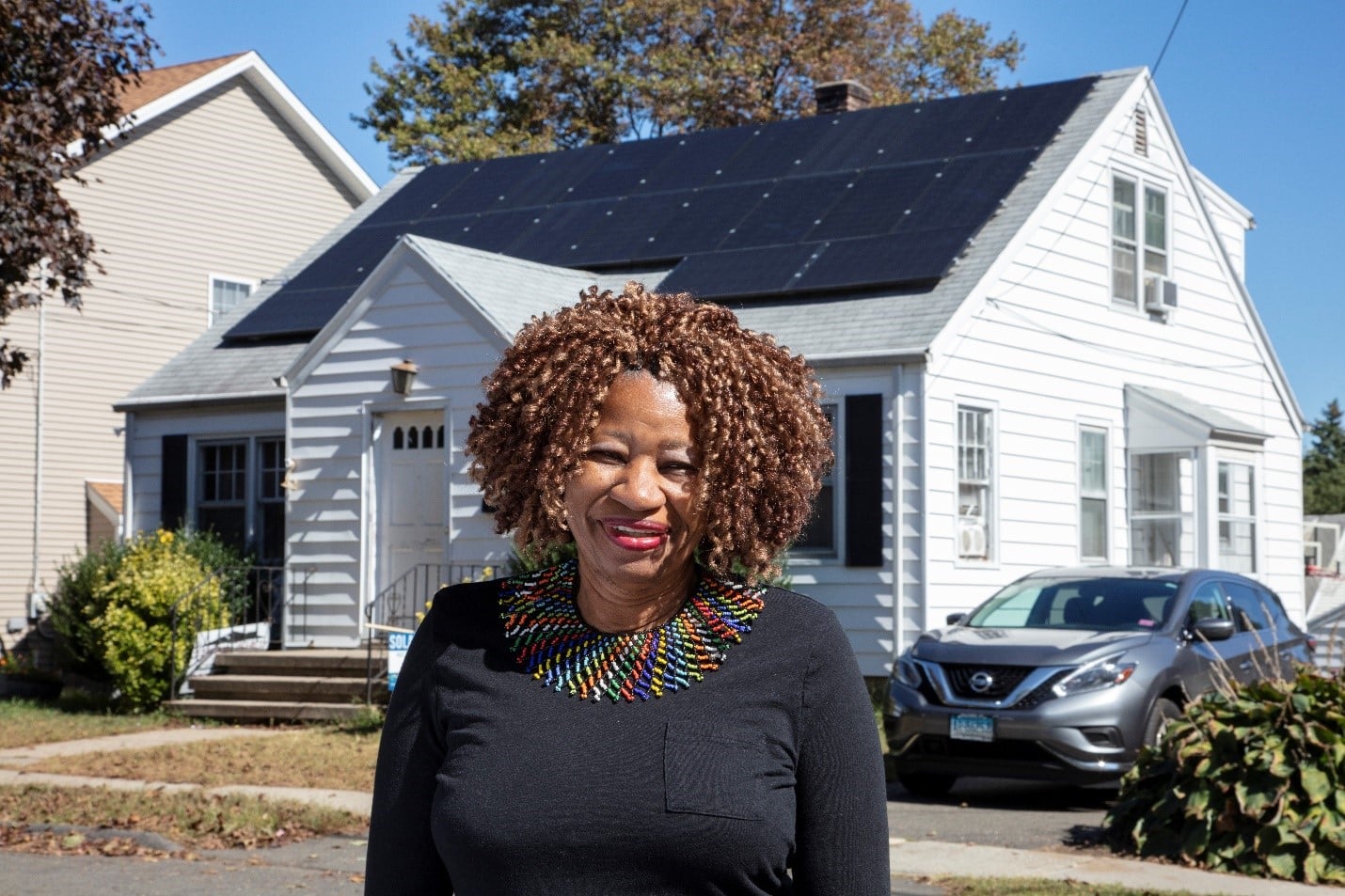Connecticut’s Green Liberty Bonds: Finance Innovation and Public Participation in Clean Energy

Coretta went solar in 2019 to help improve the environment for her grandkids. Photo courtesy of Connecticut Green Bank.
The Connecticut Green Bank has created Green Liberty Bonds, a new type of green bond from which the proceeds are invested in projects that confront climate change in Connecticut. Modelled after the Series-E War Bonds of the 1940s, the bonds are structured to be purchased by retail investors, through lower-dollar denominations, enabling ordinary people to directly participate in the green economy and earn a return on their investment. The bonds are Climate Bond Certified and currently carry a rating by S&P of A+. The bonds are backed by a unique revenue stream created by the sale of Solar Home Renewable Energy Credits (SHRECs), which are generated by the solar panels on homes that received state incentives for going solar. In honor of the 50th anniversary of Earth Day, the first issuance of the bonds in July 2020 sold nearly $17 million, and the second issuance in May 2021 sold nearly $25 million in investments.
Increasing Local Investment in Clean Energy
The Connecticut Green Bank facilitates clean energy deployment by leveraging a public-private financing model that uses limited public dollars to attract private capital investments. Bonds, an investment tool well known to large and small investors, are still under-utilized to fund clean energy projects, let alone programs. Green bonds, particularly, have been cited as a vehicle with the potential to bring in the necessary investment capital.
A Green Liberty Bond is a unique type of green bond that must have three specific features.
- First, the use of proceeds from the bond must go towards projects that confront climate change and support job creation in Connecticut.
- Second, modelled after the Series-E War Bonds of the 1940s, the bonds must be accessible to everyday citizens in lower-dollar denominations ($1,000 minimums).
- Third, to instill confidence and encourage investment, Green Liberty Bonds must have consumer protections built in. These bonds are independently certified and the use of proceeds as investments to confront climate change is verified.
An innovative feature of the Green Liberty Bonds is that they are backed by a unique revenue stream created by the sale of Solar Home Renewable Energy Credits (SHRECs), which are generated by the solar panels on homes that received state incentives for going solar. As opposed to other more traditional solar asset-backed securities, the revenue being used to “back” the investment is not a pool of consumer receivables originated by solar companies (like loans, leases, and PPAs), but a stream of long-term proceeds from statutorily mandated REC sales from the Green Bank to two Connecticut utilities in compliance with the state’s renewable portfolio standard (RPS).
The Green Bank has provided these homeowners with upfront incentives or performance incentives over time in exchange for the SHRECs, which are then sold to the utilities through a 15-year Master Purchase Agreement to assist them in their compliance with Connecticut’s RPS. The proceeds from the sale of Green Liberty Bonds support the deployment of more solar energy in the state.
Strong Demand Confirms Success for a New Financing Model
The inaugural offering of the Green Liberty Bonds occurred on July 29, 2020, in the midst of the COVID-19 pandemic, with the sale of $16,795,000 over a two-day period, with retail investors getting exclusive preference on the first day. These bonds were collateralized by revenue from the SHRECs from approximately 4,800 residential solar photovoltaic systems across Connecticut. These bonds were Climate Bond Certified, and at the time of issuance were rated “A” by S&P. Total retail orders received during the first day of this order period surpassed $9.9 million. With priority given to Connecticut retail investors, their orders for nearly $5 million of bonds were filled before the national orders. Due to heavy volume of interest seeking the first two years of maturities, the Green Bank was only able to fill $1 million of the more than $5 million in national retail orders placed. This transaction won The Bond Buyer Award in Innovative Financing for its structure.
A second issuance of Green Liberty Bonds occurred on May 11, 2021, with the sale of $24,834,000 of the Series 2021 Green Liberty Bonds. Again, the bonds were rated “A” by S&P and Climate Bond Certified. These bonds were collateralized by SHRECs from approximately 6,900 residential solar systems. With nearly $100 million in orders from both retail and institutional investors, demand was much greater than the supply of bonds could satisfy, showing the high-level of interest in supporting investment to confront climate change in Connecticut. Total retail orders received during the retail order preference period surpassed $20 million, while institutional orders (on the second day) topped $77 million. On the retail side, some priority was given to Connecticut retail investors, and their orders for nearly $12 million of bonds were filled before approximately $9 million of bonds were obtained by orders from individuals nationally.
Expanded Benefits to More Connecticut Communities
The proceeds of 2020 and 2021 issuances of the Green Liberty Bonds were used to support the Connecticut Green Bank for the incentives and program administration costs related to the Residential Solar Investment Program (RSIP), an initiative designed to make rooftop solar installations more affordable in Connecticut. The solar PV systems that backed these bond issuances supported the creation of 3,391 direct, indirect, and induced jobs; generated 10,485,805 in individual and corporate tax revenue; and created public health outcomes valued between $48 million and $100 million. Additionally, these systems had positive environmental benefits, with lifetime emissions avoidance of more than 1.5 million tons of CO2, 1.5 million pounds of NOX, 1.4 million pounds of SOX emissions, and 120,000 pounds of small particulates (PM2.5).
A key focus of Green Liberty Bonds is to appeal to retail investors from both an investability standpoint and an impact-investment standpoint. Low denomination minimum purchase requirements, combined with credit support from the State of Connecticut, make the investment affordable for retail investors. In addition, investors can rely on the Climate Bond Certified designation attached to the use of the bond issuance proceeds, which is why the Green Bank chose to have the bonds certified as green by a third-party verification service.
Due to the success of the first two issuances, the Green Bank intends to offer Green Liberty Bonds on or around each Earth Day in the future. After the first issuance in 2020, Green Bank leadership received inquiries from other states and nonprofit organizations seeking information about replicating this product to support other green causes like voluntary carbon offsets for forest protection. The Green Bank encourages other issuers to use the Green Liberty Bond name and structure, ensuring that the three defining principles (use of proceeds for projects that support the Paris Agreement; retail accessibility of purchase; certification and verification) are in place.
In 2022, the Connecticut Green Bank was awarded a State Leadership in Clean Energy Award for their Green Liberty Bonds program by the Clean Energy States Alliance (CESA). According to an independent panel of judges, “The Green Bank has created an interesting, innovative, and highly creative way to generate revenue for clean energy projects and to increase public benefits from—and greater public participation in—investments that will accelerate funding for clean energy deployment in Connecticut.” For a detailed case study on Connecticut’s Green Liberty Bonds program, and the five other winners of the 2022 State Leadership in Clean Energy Awards, see a new report released by CESA in September 2022. Representatives from the Connecticut Green Bank will discuss the Green Liberty Bonds program in a CESA webinar on November 9 – learn more.
Published On
November 1, 2022

